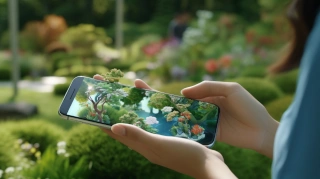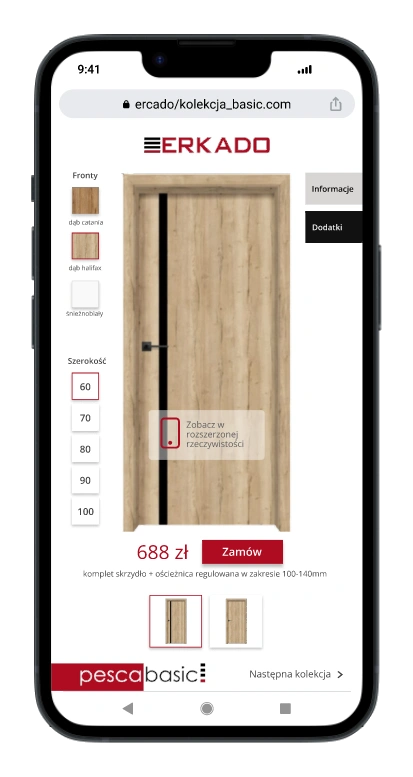AR glasses and their purpose

AR glasses, also known as augmented reality glasses or mixed reality glasses, are wearable devices that overlay digital information onto the user's real environment. These devices allow users to see and interact with virtual objects and information in their environment. AR glasses work by incorporating different technologies such as sensors, cameras and displays to create an immersive augmented reality experience. They bridge the gap between the physical and digital worlds, allowing users to access a wealth of information and improving their perception of reality.
Where are AR glasses finding use?
AR glasses have found applications in areas such as gaming, education, healthcare, engineering and entertainment. In education, for example, they can be used to provide interactive and immersive learning experiences, allowing students to visualise complex concepts in a more engaging and understandable way. In healthcare, on the other hand, they can assist surgeons during procedures by providing real-time information and guidance. The possibilities of these devices are endless and their potential to revolutionise different industries is enormous.
Understanding how AR glasses work is important as it allows users to take full advantage of their capabilities and the benefits they offer. By understanding the underlying technology and functionality, users can make informed decisions about their choice of glasses based on their specific needs. In addition, learning how they work can help developers and innovators design and create new applications and experiences for these devices.
Also read: augmented reality: hit or miss?
The technology behind AR glasses
AR glasses use advanced display technology to overlay digital content onto the real world. These devices typically use transparent screens or screens integrated with lenses. This allows users to see both the virtual content and the surrounding environment at the same time. The display technology used in AR glasses is key to providing a seamless and immersive augmented reality experience. For example, in applications developed for HoloLens (https://www.microsoft.com/pl-pl/hololens/apps), AR glasses showcase their capabilities by allowing users to view 3D content and visualise it as if it were 3D. Display technology plays an important role in presenting digital information and graphics in a way that seems integrated with the real world.
Also read: how much does AR cost?
What are augmented reality glasses made of?
AR glasses contain various sensors and tracking systems that accurately detect and observe the user's head movement and position in space. These sensors include accelerometers, gyroscopes and motion sensors. By continuously monitoring the user's movements, these pieces of hardware can adapt the displayed content to the perspective in real time. This tracking capability is essential to maintain the illusion of virtual objects anchored in the real world. Additionally, some AR glasses use SLAM (Simultaneous Localization and Mapping) technology, which combines sensors and software to map the user's surroundings and track them. These sensors and systems work together to provide a precise and accurate augmented reality experience.
The computing power and software in AR glasses are responsible for rendering and displaying digital content in real time. To create an augmented reality experience, AR glasses need to process and overlay virtual content on top of the user's view of the real world. This requires significant computing power, which is usually provided by the device's internal operating system. The software running in the glasses coordinates sensors, tracking systems and display technology to seamlessly integrate elements of the virtual and real worlds. The combination of powerful processing capabilities and advanced software, enables AR glasses to deliver immersive and interactive experiences.
Check out our 3D configurator.
How do AR glasses create reality?
AR glasses create augmented reality experiences by overlaying digital information onto the real world. This technology allows users to view and interact with virtual objects and information in their physical environment. Using devices such as smartphones, tablets or special glasses, digital elements such as images, 3D graphics or additional information can be seamlessly integrated into the user's field of vision. Unlike virtual reality (VR; read about thedifferences between AR and VR on our blog), in which the user is completely immersed in a simulated environment, augmented reality keeps the user in the real environment and enriches it with digital overlays.
AR glasses play a key role in delivering the augmented reality experience, providing a handy and hands-free display. This overlay of information provides a seamless integration of the virtual and physical worlds, opening up a wide range of possibilities for a variety of applications in areas such as gaming, education, healthcare and beyond. Interaction and control mechanisms are key elements of AR glasses. One example of an interaction mechanism is hand gesture recognition, which allows users to control AR glasses. Voice recognition is another commonly used mechanism that allows users to give commands and interact with virtual content using their voice.
Interaction and control mechanisms are key elements of AR glasses. One example of an interaction mechanism is hand gesture recognition, which allows users to control AR glasses. Voice recognition is another common mechanism that allows users to give commands and interact with virtual content using their voice. In addition, some AR glasses may include eye-tracking technology, which allows for more intuitive control by detecting the user's eye movements and directing virtual content accordingly. These interaction and control mechanisms improve the user experience and make it more immersive and natural. As the technology advances, we can expect the interaction and control mechanisms to develop further, providing users with an even smoother and more intuitive augmented reality experience.
AR glasses companies
There are many companies on the market that manufacture augmented reality (AR) glasses. Here are three examples of companies that are known for producing AR glasses:
- Microsoft – this company is responsible for creating the famous AR glasses called Microsoft HoloLens.HoloLens combines the real world with the virtual world, allowing users to interact with holographic objects and information directly in their environment.
- Google – Google has also launched its own AR glasses called Google Glass.These glasses allow users to view information, use apps and perform other activities without the need for traditional mobile devices.
- Magic Leap – Magic Leap is an innovative company that develops and manufactures advanced AR glasses. Their product, Magic Leap One, offers high visual and audio quality, allowing users to interact with virtual objects in their real environment.
However, it is worth bearing in mind that the AR glasses market is dynamic and new companies and technologies may emerge in the future. Before purchasing AR glasses, it is advisable to thoroughly research the market and familiarise yourself with the various options and innovations available.
Finally, I encourage you to visit seemymodel.com and see how 3D visualisation of products using AR works in practice.
Do you like the post? Share to others!

Krzysztof Basista
COO
For years, he has been involved in AR / VR projects ranging from entertainment to heavy industry. Always looking for problem solving through technology.
Contact us
Related posts

Not so long ago, augmented reality was a science fiction subject, fascinating but distant. Today, it is at our fingertips, literally. Our smartphones...

3D AR configurators, combining augmented reality technology with 3D modelling, are becoming increasingly popular in industries ranging from furniture to automotive.

Augmented reality (AR) has become a powerful tool in the hands of marketers, enabling the creation of memorable, interactive experiences for customers.

Augmented reality (AR) is no longer just the domain of games and entertainment - it is now increasingly making its presence felt in tourism...

Have you wondered what it would be like if the boundaries between the virtual world of games and reality began to blur? In recent years...

Augmented reality (AR) is increasingly boldly entering the classroom, offering new, interactive teaching methods. It transforms...






